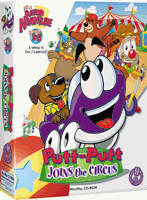Jacquie Kubin describes how Humongous' focus on story and characters has sold over 16 million games and counting.

It all began with an endearing little car, Putt-Putt, envisioned and created by a group out of Seattle called Humongous Entertainment, an Infogrames, Inc. company. Like the Little Train that could, Putt-Putt can do almost anything and his first adventure (1992) took him to the moon. "Putt-Putt is the flagship title of the company," says Brad Carlton, Design Director, Humongous Entertainment, Inc. "He led the way for the children's adventure game genre in a company founded by traditional adventure game designers Ron Gilbert and Shelley Day, who recognized that the market for intriguing, interactive game play for children was there."

Putting Story and Character First
The genesis of the company, which has sold more than 16 million games to date, was to fill a niche being ignored by other game developers -- story driven, versus activity driven, game play for kids. Their first character, Putt-Putt is a caring, loving, helpful little friend within the body of a purple car. Putt-Putt and his other Humongous Entertainment friends, Pajama Sam, Freddi Fish and SPY Fox, reside in richly detailed animated worlds that allow for a child's interactive exploration and learning. Each of these worlds foster fun, companionship, helping and other important life skills.

"One of the things that makes us a leader is that the characters are engaging, bringing the kids into the evolving stories," Carlton explains. "The games draw people in and both the children and the parents have fun with the products. We take our roles very seriously here and we want to teach our users how to be social people in a social world."
When creating a new story driven adventure or sports titles, the Humongous Entertainment team begins with the story line and script. The group uses movie and comedy writers, which helps provide entertainment value for parents, while crafting a story that is entertaining and exciting for children.

In the development of their soon to be released (Fourth Quarter/October) The Backyard Soccer MLS Edition, Humongous Sports has added the child personas of fifteen professional soccer players such as Cobi Jones of the LA Galaxy, Ben Olson of DC United and Brianna Scurry and Brandi Chastain from the U.S. Women's National Team, and winners of the World Cup, to the game.
As with other Humongous Sports titles, Backyard Baseball and BackyardFootball features a recurring group of thirty children, boys and girls, of various race, religious background, physical and athletic ability. These children include twins Ashley and Sidney Webber, who make a dynamic duo when playing together, brothers Achmed and Amir Kahn, and the sister-brother team of Vicki Kawaguchi, who is an aspiring prima ballerina, and Kenny, who plays games with precision from his wheelchair.
Adding real life athletes to the game makes it that more exciting for the children, providing positive future life role models based on real live people.
"We did not just create characters and given them real sports stars names," says Elizabeth Stringer, Director of Development, Sports. "When playing the Backyard Sports games, children are as picky as they are in real life and they will choose the Backyard children that they best relate to. Same goes with the professional children, so we went to those sports stars and asked them their favorite colors, foods, music and other things that children relate to."
Complexity Through The Ages
The Backyard Sports games contain as much complexity as an adult game. They offer variations such as single play, seasonal play and the ability to track player statistics. Each Backyard Sports game begins with an approximate 800 page script of positive and self-esteem building comments and the lesson that all children can play, though each child has different strengths.

A unique aspect of Backyard Soccer is the inclusion of female sports stars, something not seen in football and baseball...yet.
"We have tried to build in some important lessons, one being that each child can contribute, even Kenny who can 'kick' an extremely accurate ball from his wheelchair," explains Stringer. "It's exciting for me to be able to add the professional female characters, showing young girls that they can also aim for a future in sports."

Adding to the developmental challenges for Humongous Games is that unlike a game that is geared for one specific age group, a Humongous Entertainment game offers repeat play for children over an extended life period. For example, the recently released game, Putt-Putt Joins the Circus reflects an age appropriateness from three to eight.
This is accomplished through games that are not level based, such as an adult first person shooter game would be. Instead the on screen interactivity is continually broadening. Additionally the games are not one goal oriented, instead providing numerous concurrent goals, which are attainable at different developmental ages.
"Any one who has children, or has worked with children, knows that a three year old is very different emotionally, physically and mentally from an eight year old," says Stringer. "One of our challenges is to be able to create games that will continue to educate and entertain throughout this growth period."

Animation and Outlets
In addition to the writing staff, creating any of the Humongous Entertainment and Humongous Sports titles also takes a full compliment of at least seven animators that create each frame the old fashioned way...by hand. For each game, this team is required to create hundreds of thousands of frames, even more for the sports games due to the multiple characters and hundreds of possible on screen interactions.
A Junior Adventure game, such as the new SPY Fox title scheduled for release first quarter 2001, may have two to three times as many frames as a half hour cartoon show.
"Our artists first animate traditionally and those drawings are scanned in," says Carlton. "The computer is used to color, ink, paint and animate, but the games have the warm traditional animated movie feel because we use movie techniques in order to squash, stretch, overshoot or blur frames."
The company relies on an animation software program they developed, though they do use Maya for some of the 3D animation on the sports games as it provides a real-time feel for the players.

 Backyard Football is expanding its game play -- Playstation and Gameboy, here they come! © 2000 Humongous Entertainment. All rights reserved. Freddi Fish, another interactive friend fostering learning for Humongous. © 2000 Humongous Entertainment. All rights reserved.
Backyard Football is expanding its game play -- Playstation and Gameboy, here they come! © 2000 Humongous Entertainment. All rights reserved. Freddi Fish, another interactive friend fostering learning for Humongous. © 2000 Humongous Entertainment. All rights reserved.
"Everything we do is very film-like in that each release is first storyboarded -- in effect played all the way through before the art process begins," says Stringer.

The company employs more than eighty artists who in general all share a hand and have strong animation backgrounds. Releases usually take just under a year to develop, in comparison with the 18 months that adult/traditional games often take.
"There is a tremendous talent base here and we have all gone through the learning curve together so we are good at what we do," says Carlton. "There is a misconception that we must not work as hard on 'children's' titles, but in reality they are more difficult because of the scripting. People love this company; working here even though it is difficult. Of course, we are so good at it, it doesn't seem so from the outside."
The next hurdle for Humongous Entertainment and Humongous Sports titles is the transfer to Playstation and Gameboy Color scheduled in time for the 2000 holiday season. The move to the console market is a result of the release of new generation machines, in particular the Playstation 2.
"The children's market has a price sweet spot of around twenty dollars," explains Stringer. "In the past, royalties to Sony made the cost of developing for the console prohibitive. With the new generation machine, those costs are drastically reducing. Gameboy already sells well into the children's market paving the way for our games."
Putt-Putt Online
And the next frontier for the game developer may very well be cyberspace. The company already has very child friendly, game and interactivity packed Websites that include elements of online gaming. At Humongous.com, children can play familiar games such as Concentration, Tic-Tac-Toe and Checkers featuring characters like Freddi Fish, Pajama Sam, SPY Fox and, of course, Putt-Putt. The Backyard Sports games Football and Baseball both provide an on-line multiplayer element that allows for head-to-head cyber-competition. Players of the sports games will require both an Internet connection and the game CD-Rom. Both sites provide community elements for the children, including The Sidelines at HumongousSports.com.

"We have more than thirty thousand unique children playing the on-line sports games," confides Carlton. "The sports site also features The Sidelines, a place where kids can meet and chat on delayed bulletin boards, check out player statistics, read game hints and find downloadable goodies such as wall paper, coloring pages, screen savers and sounds."
Those elements, but featuring the Junior Adventure characters, also bring children back to the Humongous.com site. The e-commerce elements to the sites allow easy shopping and products from hand-held to box games can be purchased. In addition, premiums, such as a Pajama Sam lunchbox or Putt-Putt T-shirt, can be obtained when pre-ordering upcoming releases. A next step will be delivering games online, a process that the company is exploring.
"The backbone for this process is in place, but the question is whether consumers are ready to begin looking for electronic entertainment products to originate online," says Stringer. "We are also very concerned about ensuring that the online worlds we develop are safe and secure for young children and their families. So while this is an important growth area for us, it is one we are approaching cautiously."
Jacquie Kubin, a Washington, DC-based freelance journalist, enjoys writing about the electronic entertainment and edutainment mediums, including the Internet. She is a frequent contributor to the Washington Times and Krause Publication magazines. She has won the 1998 Certificate of Award granted by the Metropolitan Area Mass Media Committee of the American Association of University Women.








